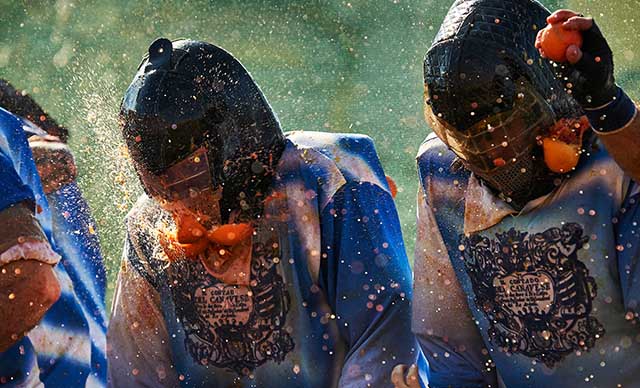
Avete mai avuto la voglia di lanciare un’arancia contro qualcuno? Boh, certo ogni tanto viene il desiderio a tutti noi di gettare la frutta contro un presuntuoso politico o un comico poco divertente…o uno dei cantanti o i presentatori di Sanremo. Ma per fortuna, almeno nella maggior parte dei casi, la cortesia e la civiltà regnano e resistiamo alla tentazione.
Have you ever had the urge to throw an orange at someone? Well, certainly every so often we all get a hankering to throw fruit at some pompous politician or a not so funny comedian…or a singer or presenter at Sanremo. But fortunately, at least in most cases, politeness and civility reign and we resist the temptation.
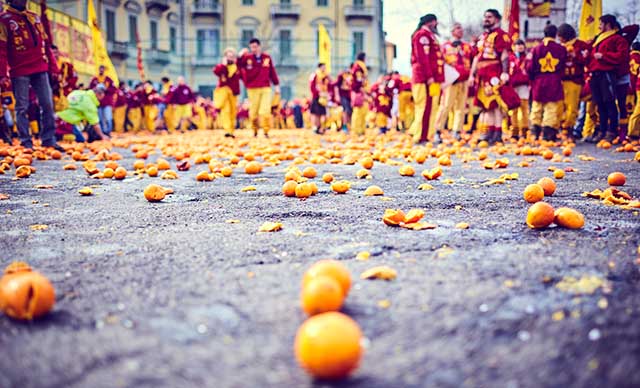
Però una volta ad anno potete lasciarvi andare pazzi e lanciare tutta la frutta che volete a Ivrea, una piccola città in nord Italia vicino a Turin. In breve, sto parlando di una manifestazione che ci danno ogni anno a Carnevale, un tipo di finta battaglia, che coinvolge migliaia di cittadini che sono divisi in nove squadre che lanciano arance in un modo proprio spaventoso a loro “nemico”, le guardie ducali.
However, once a year you can all let yourselves go crazy and launch all the fruit you like in Ivrea, a small city in northern Italy near Turin. In short, I am talking about an event they have at Carnival, a type of mock battle, that involves thousands of townspeople who are divided up into nine squadrons who launch oranges in a rather scary way at their “foe”, the ducal guards.

È una rievocazione di un episodio di affrancamento dalla dittatura di un duca locale che si fa risalire al medioevo. La ribellione fu iniziata dalla figlia di un mugnaio. Secondo una versione della storia Violetta, la Mugnaia (la figlia del mugnaio) ha rifiuto di accettare il “diritto” del duca di trascorrere una notte con ogni donna appena sposata. In un atto di sfida ha tagliato la sua testa. Mi fa pensare un po’ di Judith e Holofernes. Ad ogni modo la Mugnaia è diventata l’eroina ed è stata elevata a simbolo della libertà conquistata da tutto un popolo in rivolta contro il tiranno feudale.
It is a re-enactment of an episode of liberation from the dictatorship of a local duke and goes all the way back to the middle ages. The rebellion was begun by the daughter of a miller. According to one account, Violetta, la Mugnaia (the Miller’s daughter) refused to accept the “right” of the duke of spending the night with each newly wedded woman. In an act of defiance she cut off his head. It makes me think of Judith e Holofernes. In any case la Mugnaia became a heroine and was elevated to symbolize freedom won by a people revolting against Feudal tyranny.
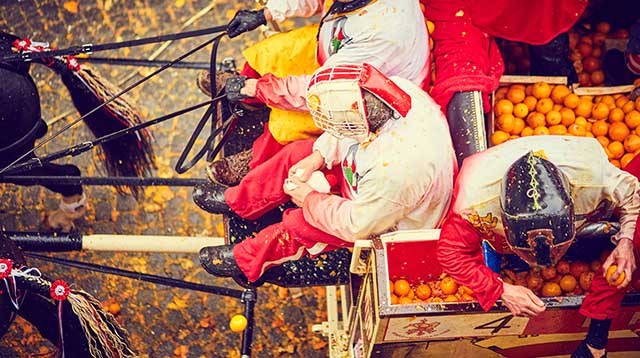
Oggi la battaglia ha per teatro le principali piazze della città. Prima della battaglia c’è un corteo e tanta gente si veste in costumi. La Mugnaia, veste di bianco, è il personaggio principale della festa. Poi entrano i carri tirati dai cavalli e pieni “i duchi di guardia” chi indossano maschere terrificanti. A piedi sono i rivoluzionari o gli “aranceri” che indossano cappelli rossi per distinguersi. Ogni banda a piedi è formata da molte decine di aranceri – uomini e donne – che vanno all’assalto del carro che transita dalla piazza cercando di colpire soprattutto gli avversari sulla maschera protettiva.
Today the stage for the battle are the principal piazzas of the city. Before the battle there is a procession and people dress in costumes. La Mugnaia, dressed in white, is the guest of honor and principal figure of the celebration. Then enter the carriages pulled by horses and filled with “the dukes guards” who wear terrifying masks. On foot are the revolutionaries o the “aranceri” (orange throwers) that wear red hats to distinguish themselves. Every band on food is formed of tens of orange throwers – men and women – that attempt to assault the wagons that pass from the square trying to hit their opponents above the protective masks.
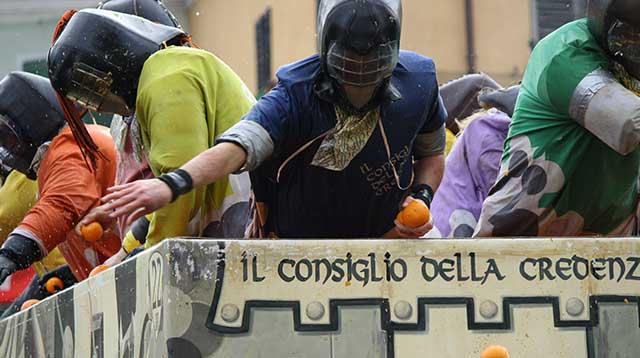
L’origine della tradizione di gettare arance non è ben compreso, in particolare perché le arance non crescono ai piedi delle Alpi italiane e devono essere importato dalla Sicilia. La mia teoria è il succo rosso delle arance assomiglia un po’ il sangue! Ma quanti arance ci sono! Ivrea deve sa di arance per tutto l’anno! Nel 1994 è stato stimato che 265,000 chilogrammi di arance sono stati portati alla città per l’evento.
The origins of this orange throwing battle aren’t that clear, especially since oranges aren’t grown at the foot of the Italian Alps and they must be imported from Sicilia. My theory is that the red juice of the blood oranges looks a lot like, well blood! But wow! How many oranges there are! Ivrea must smell like oranges the whole year round! In 1994 it was estimated that 265,000 kilograms of oranges were brought into the city for the event.
Quest’anno la battaglia delle arance comincia oggi 19 febbraio e dura fino a 21 febbraio. Se volete partecipare nello spettacolo dovreste affrettarvi a Ivrea! Forse ci farebbe tutto un mondo di bene di gettare alcune arance sfogare i nostri problemi quotidiani!! È meno pericoloso di gas lacrimogeno e proiettili e molto più sano specialmente in una sorta di “Vitamina C” modo! Caspita io adoro questo paese! Voglio dire, chi non vorrebbe essere colpito alla testa con un gran bel pezzo di frutta che trasuda! Cosa folle faranno dopo?
This year the battle of the oranges begins today, February 19th and lasts until February 21. If you want to join in the fun you should hurry up and get yourselves to Ivrea! Perhaps it would do us all a world of good to throw a few oranges to vent our daily problems! It is safer than tear gas and bullets and healthy in a Vitamin C kind of way! Wow. How much do I love this country? I mean, who wouldn’t want to be hit in the head with a great big oozing piece of fruit! What crazy thing will they do next!
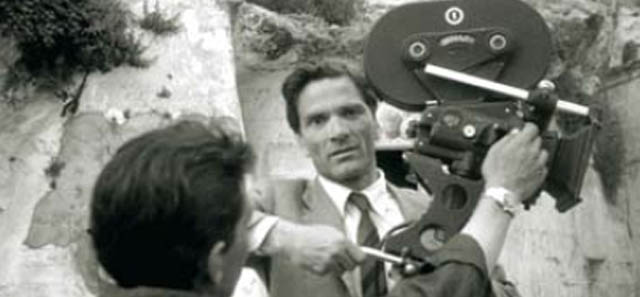
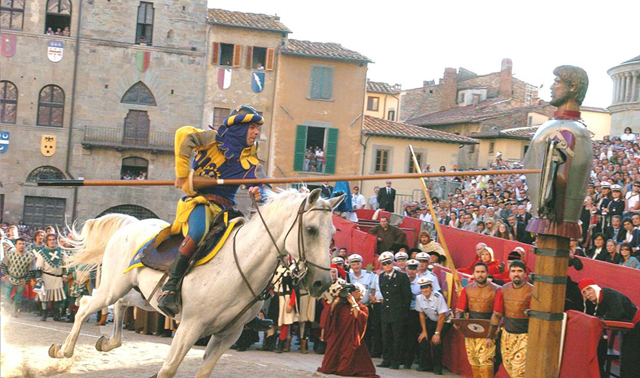

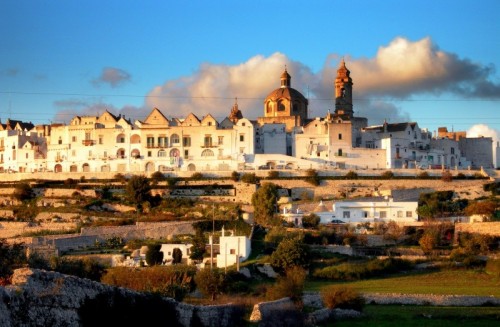







Pazzissimo!!!!!!!! 🙂 Perche gli uomini nella carretta indossono “helmets” e gli altri non????
C’e un piccolo paese in Spagna che fa la stessa cose con pomodori…
Grazie, Melissa. Che divertente.